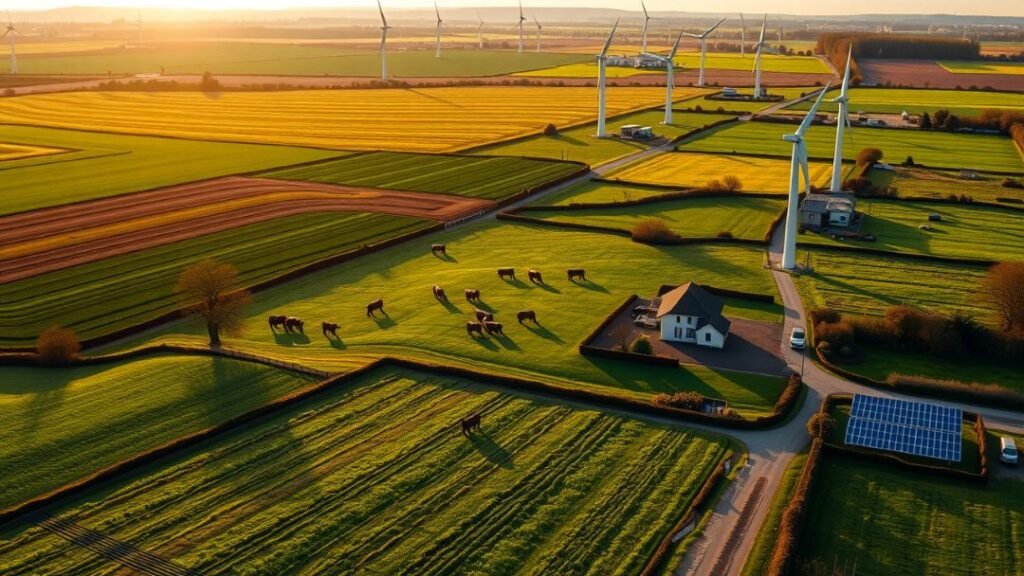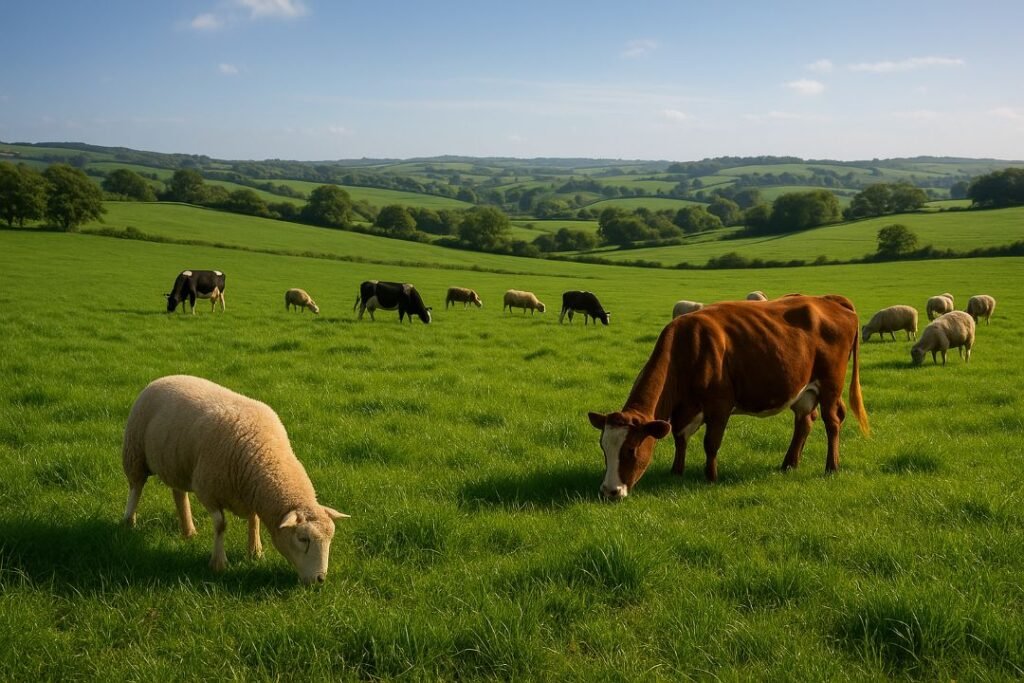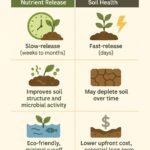
The race to combat climate change is on, and agriculture is at the forefront. Western countries, including the USA, Canada, and the UK, have set ambitious goals to reach net zero emissions by 2035–2050. But here’s the challenge: agriculture accounts for 37% of global greenhouse gas emissions (World Economic Forum, 2024). The good news? Regenerative agriculture offers a practical path to net zero farming. By focusing on soil health, carbon sequestration, and sustainable practices, farmers can reduce emissions while boosting productivity. Let’s explore how regenerative agriculture can lead Western farms to a net zero future.
What is Regenerative Agriculture?
Regenerative agriculture is a set of farming principles and practices that aim to restore soil, increase biodiversity, and reduce carbon emissions. Unlike conventional methods that often degrade land, regenerative farming enhances ecosystem functions.
Key Principles:
- Improving soil health through cover crops, compost, and no-till farming.
- Enhancing biodiversity with crop rotation and agroforestry.
- Reducing reliance on synthetic inputs like chemical fertilizers.
- Integrating livestock in ways that recycle nutrients and improve soil structure.
In the USA and Europe, regenerative agriculture is increasingly recognized as a central pathway to achieving climate-smart farming and net zero goals. For example, the European Green Deal highlights regenerative farming as essential for soil restoration by 2030.
Key Practices for Achieving Net Zero Farming
3.1 Cover Cropping & Crop Rotation
Cover crops such as clover, rye, and alfalfa help prevent soil erosion, fix nitrogen, and build organic matter. When combined with crop rotation, they disrupt pest cycles and reduce fertilizer demand.
To know about “The power of crop rotation in regenerative farming” Click Here
Case Study: A farm in Iowa, USA, that adopted cover crops saw a 32% reduction in nitrogen runoff and improved soil organic matter within five years (USDA, 2021).
Benefits for Net Zero:
- Enhances soil carbon sequestration.
- Reduces fertilizer emissions.
- Improves resilience against drought and floods.
Healthy soils act as massive carbon sinks. Regenerative practices increase carbon storage through:
- Biochar application – locking carbon in stable forms.
- Compost integration – improving microbial activity.
- No-till farming – reducing soil disturbance and carbon release.

In the UK, carbon farming initiatives show that regenerative techniques can store 0.5–1.2 metric tons of carbon per acre annually (UK Carbon Farming Report).
3.3 Livestock & Emission Reduction
Livestock farming contributes significantly to methane emissions. Regenerative livestock systems tackle this through:
- Rotational grazing – mimicking natural herd movement to improve pasture health.
- Methane-reducing feed additives (e.g., seaweed-based).
- Manure management – converting waste into bioenergy or organic fertilizer.

Case Study: In Scotland, a regenerative sheep farm cut methane emissions by 17% using seaweed supplements (FAO, 2022).
Role of Precision Farming & Technology
Modern technology enhances regenerative agriculture by making it more efficient and measurable:
- Drones monitor crop health and soil conditions.
- IoT sensors track soil moisture and nutrient levels.
- AI-driven tools recommend optimal crop rotations.
- GPS precision seeding reduces waste and improves yield.
This synergy between smart farming and regenerative practices is helping Western farmers achieve both profitability and sustainability.
Economics of Regenerative Farming
Switching to regenerative agriculture requires investment, but the long-term benefits outweigh costs.
| Farming Type | Avg. Cost per Acre (USD) | ROI over 10 Years | Carbon Credit Potential |
|---|---|---|---|
| Conventional Farming | $550 | Moderate | Low |
| Regenerative Farming | $600–650 | High | Significant (up to $40/acre annually) |
According to the World Bank, regenerative farms can achieve 20–30% higher profitability over time due to reduced input costs and higher soil productivity.
Government Incentives & Policy Support
Governments in the West are actively promoting regenerative practices:
- USA: USDA’s Climate-Smart Commodities program offers billions in grants.
- UK: The Environmental Land Management Scheme (ELMS) pays farmers for ecosystem services.
- Canada: Federal tax credits and carbon markets encourage carbon farming.
Such incentives lower the barrier for farmers to transition and accelerate adoption.
Challenges and Solutions
| Challenge | Impact | Solution |
|---|---|---|
| High upfront costs | Farmers hesitate to switch | Subsidies, low-interest green loans |
| Knowledge gap | Lack of training in regenerative practices | Farmer training, extension programs |
| Market resistance | Buyers skeptical of new practices | Certification & consumer awareness campaigns |
Community-based initiatives and farmer-to-farmer networks are also proving vital in knowledge transfer.
Future Outlook: Net Zero by 2035
By combining regenerative practices with precision technology, Western agriculture can drastically reduce emissions. Farmers play a central role, but policymakers and consumers must also support this shift.
If adopted at scale, regenerative agriculture could sequester up to 1.2 gigatons of CO₂ annually by 2035, enough to significantly contribute to net zero goals (IPCC, 2023).
Conclusion
Regenerative agriculture offers a pathway to healthier soils, lower emissions, and higher farm profitability. By adopting practices like cover cropping, carbon farming, and precision technology, Western farmers can lead the charge toward net zero by 2035.
Action Plan for Farmers: Start small with cover crops, explore carbon credit opportunities, and leverage government programs to reduce transition costs.
The future of farming is regenerative—sustainable for both the planet and the farmer.
FAQs
1. What is regenerative agriculture and how does it relate to net zero farming practices USA?
Regenerative agriculture is a set of practices that restore soil health and sequester carbon. In the USA, it’s central to achieving net zero agriculture.
2. How much does it cost per acre to switch to regenerative agriculture?
Typically $600–650 per acre, but long-term savings on fertilizers and access to carbon credits improve ROI.
3. Which soil carbon sequestration techniques work best for small farms?
No-till farming, compost application, and agroforestry are most effective and affordable for small-scale farmers.
4. What government incentives are available in Canada/UK/USA for regenerative farmers?
Examples include USDA Climate-Smart grants (USA), ELMS payments (UK), and carbon credit schemes (Canada).
5. How can precision farming accelerate net zero agriculture?
By using drones, sensors, and AI to optimize resource use, reduce waste, and maximize soil carbon capture.

